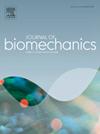Passive-dynamic ankle-foot orthoses change post-stroke lower extremity constituent work profile
IF 2.4
3区 医学
Q3 BIOPHYSICS
引用次数: 0
Abstract
Stiffness-customized passive-dynamic ankle–foot orthoses (PD-AFOs) have been shown to reduce the mechanical cost of transport (COT) of individuals post-stroke. However, the mechanisms underlying this reduced COT are unknown. Therefore, this study aimed to identify the factors driving COT reduction with PD-AFO use for individuals post-stroke. Results showed that changes in limb work were strongly correlated to changes in COT with the PD-AFO compared to No AFO in the paretic (tau = 0.637, p < 0.001) and non-paretic (tau = 0.621, p < 0.001) limbs. There was also a strong correlation between changes in limb work and changes in COT compared to SOC AFO in the paretic (tau = 0.569, p < 0.001) and non-paretic (tau = 0.503, p = 0.003) limbs. Conversely, changes in stride length and changes in COT were not correlated. Changes in COT between No AFO and PD-AFO were moderately correlated to the number of constituents that performed less mechanical work for both the paretic (tau = −0.462, p = 0.009) and non-paretic (tau = −0.402, p = 0.025) limbs. Compared to walking with SOC AFOs, there was a moderate correlation between COT and the number of constituents in the paretic limb (tau = −0.458, p = 0.011) but not the non-paretic limb (tau = −0.247, p = 0.173). These findings indicate that PD-AFOs reduce COT primarily through small changes in work across many lower limb constituents. Understanding how COT reduction occurs can help optimize PD-AFO design and possibly other rehabilitation interventions for individuals post-stroke.
被动动态踝足矫形器改变了中风后下肢的工作状况。
僵硬度定制的被动动态踝足矫形器(PD-AFOs)已被证明可以降低中风后患者的机械运输成本(COT)。然而,降低运输成本的机制尚不清楚。因此,本研究旨在确定脑卒中后患者使用踝足矫形器降低运输成本的驱动因素。结果显示,与无AFO相比,使用PD-AFO后肢体工作的变化与瘫痪者COT的变化密切相关(tau = 0.637,p<0.05)。
本文章由计算机程序翻译,如有差异,请以英文原文为准。
求助全文
约1分钟内获得全文
求助全文
来源期刊

Journal of biomechanics
生物-工程:生物医学
CiteScore
5.10
自引率
4.20%
发文量
345
审稿时长
1 months
期刊介绍:
The Journal of Biomechanics publishes reports of original and substantial findings using the principles of mechanics to explore biological problems. Analytical, as well as experimental papers may be submitted, and the journal accepts original articles, surveys and perspective articles (usually by Editorial invitation only), book reviews and letters to the Editor. The criteria for acceptance of manuscripts include excellence, novelty, significance, clarity, conciseness and interest to the readership.
Papers published in the journal may cover a wide range of topics in biomechanics, including, but not limited to:
-Fundamental Topics - Biomechanics of the musculoskeletal, cardiovascular, and respiratory systems, mechanics of hard and soft tissues, biofluid mechanics, mechanics of prostheses and implant-tissue interfaces, mechanics of cells.
-Cardiovascular and Respiratory Biomechanics - Mechanics of blood-flow, air-flow, mechanics of the soft tissues, flow-tissue or flow-prosthesis interactions.
-Cell Biomechanics - Biomechanic analyses of cells, membranes and sub-cellular structures; the relationship of the mechanical environment to cell and tissue response.
-Dental Biomechanics - Design and analysis of dental tissues and prostheses, mechanics of chewing.
-Functional Tissue Engineering - The role of biomechanical factors in engineered tissue replacements and regenerative medicine.
-Injury Biomechanics - Mechanics of impact and trauma, dynamics of man-machine interaction.
-Molecular Biomechanics - Mechanical analyses of biomolecules.
-Orthopedic Biomechanics - Mechanics of fracture and fracture fixation, mechanics of implants and implant fixation, mechanics of bones and joints, wear of natural and artificial joints.
-Rehabilitation Biomechanics - Analyses of gait, mechanics of prosthetics and orthotics.
-Sports Biomechanics - Mechanical analyses of sports performance.
 求助内容:
求助内容: 应助结果提醒方式:
应助结果提醒方式:


